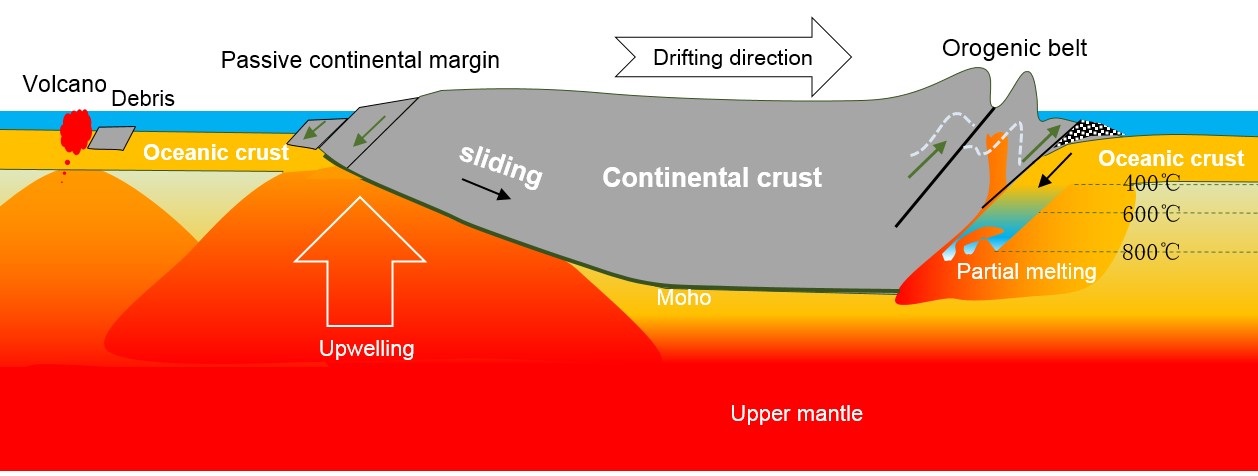博文
重磅!大陆漂移驱动力研究获重大进展 Significant advances in continental drift
||
近期,中国科学院地质与地球物理研究所梁光河博士在大陆漂移驱动力研究方面取得重大进展。相关研究结果以“从南大西洋裂解过程解密大陆漂移的驱动力”为题将发表在《地学前缘》上。
Recently, Dr. Liang Guanghe from Institute of Geology and Geophysics, Chinese Academy of Sciences, has made significant progress in their research on the driving forces of continental drift. The findings will be published on the journal Earth Science Frontiers, titled "Decipher the driving force in continental drift from new insights about the South Atlantic breakup process".
自魏格纳一百年前提出大陆漂移假说以来,驱动板块运动的动力机制一直是地球系统科学研究中的顶级科学问题。地球上的大陆板块都会发生漂移运动是不争的事实,但到底是什么动力驱动它们运动则一直存在争议。传统上有两种动力模型,一种是海底扩张“推力”模型,认为在洋中脊处不断生成的大洋板块对大陆板块产生了推力,但它难以合理解释大洋上广泛分布的大陆残片。另一种是大洋俯冲板片拖曳“拉力”模型,认为大陆板块前面俯冲下去的大洋板块因密度增加产生向下的拉力,拉动大陆板块运动,但它难以合理解释大西洋两侧的板块运动,因为那里并不存在板块俯冲拖拽力。
Ever since Wegener proposed the hypothesis of continental drift one hundred years ago, the dynamic mechanism that drives the continent movement has been one of the most important questions in earth sciences. It is a fact that continent can drift or move, but what drives the continent drift or move is a matter of debate. Traditionally, there are two kinds of dynamic models. One is the seafloor spreading "push force" model, which holds that the oceanic plate constantly forming at the mid-ocean ridge pushes the continental plate, but it cannot reasonably explain the widespread distribution of continental debris on the ocean. The other is the oceanic plate subduction drag "pull force" model, which holds that the oceanic plate subducted in front of the continental plate generates downward pulling force due to density increase, the subduction plate pulls the continental plate move forward, but it is difficult to explain the plate movement on both sides of the Atlantic, because there is no subduction plate pull force.
鉴于此,梁光河博士以大陆漂移假说的发源地南大西洋为例,通过解剖两条横跨南大西洋的深反射地震勘探剖面,定量计算了驱动力的大小,提出了地幔上涌和重力滑移双驱动动力机制模型,认为大陆板块能够在热力驱动下自己发生漂移运动。这个驱动力最初来源于大陆裂解中的地幔上涌,在大陆板块后部的莫霍面产生斜坡,大陆板块会在自身重力作用下顺坡下滑而移动,移动的大陆板块会造成后部降压,降压会诱发地幔熔融体积增加再次上涌,上涌的地幔又会产生新的斜坡,大陆再次顺坡下滑,这是一个连锁的地幔上涌和重力滑移过程。
For this reason, Dr. Liang Guanghe took the South Atlantic Ocean, the birthplace of the continental drift hypothesis, as an example. By interpreting two deep reflection seismic exploration profiles across the South Atlantic, they quantitatively calculated the magnitude of the driving force and proposed a new continent drift model driven by mantle upwelling and gravity slip. They believes that continental plates can drift by themselves rely on thermal energy. The driving force originated from the mantle upwelling in the initial stage of continental cracking, which created a slope on the Moho at the rear of the continental plate. The continental plate slide down the slope relying on its own gravity and move, and the moving continental plate cause a pressure drop behind it. Pressure drop induce the mantle melting and upwelling again, the upwelling mantle produce a new slope again, and the continent slide down again. This is a chain of mantle upwelling and gravity slip process.
大陆板块能够克服巨大阻力向前滑移,很重要的一个原因是大陆板块迎冲在大洋板块上,很多含水矿物进入俯冲带,无论陆壳还是洋壳在含水情况下熔融温度下降数百度,在俯冲带发生部分熔融形成软弱带,大陆漂移类似大陆板块不断陷入软泥的过程。该大陆漂移驱动力新模式为超越板块构造的新探索,对地球科学发展将产生巨大影响。
A very important reason why the continental plate can overcome the huge resistance to slide forward is that the continental plate thrusts on the oceanic plate, and many water bearing minerals enter the subduction zone. The melting temperature of continental crust or oceanic crust will drops by hundreds of degrees Celsius under the condition of water, so partial melting occurs in the subduction zone to form a weak zone. Continental drift is similar to the process of continental plates continuously sinking into soft mud. This model is a new exploration beyond plate tectonics. It may have great impact on the development of earth science.
全文链接(full text)
http://www.earthsciencefrontiers.net.cn/fileup/1005-2321/NEWS/20220104090706_NewsFile_61.pdf
https://blog.sciencenet.cn/blog-1074480-1319588.html
上一篇:北美洲大地构造演化简史
下一篇:老外对大陆漂移驱动力的认识